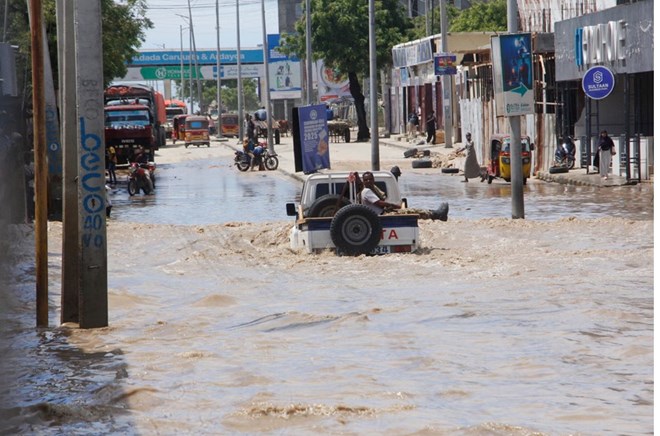
Monday May 19, 2025

Mogadishu (HOL) — Soaring food prices driven by worsening climate shocks are pushing millions of Somali families deeper into crisis, experts warn, as erratic weather devastates crops, kills livestock, and threatens to overwhelm already fragile livelihoods.
Heavy floods triggered by torrential rains since mid-April have killed at least 17 people and displaced over 8,000, tearing through makeshift camps, farmland, and urban districts already straining under the weight of mass displacement. In Banadir, nine people died in a single day when flash floods swept through Kahda and Daynille districts on May 9, destroying more than 1,000 shelters and forcing thousands to flee. At least 84,000 people have been affected nationwide, including over 9,500 displaced persons in Gaalkacyo alone.
At the same time, the country is facing a hunger crisis of staggering scale. According to the United Nations, 4.6 million people across Somalia are grappling with acute food insecurity. At the same time, 1.8 million children under the age of five are expected to suffer from acute malnutrition this year. Many of the hardest-hit communities are also those drowning under floodwaters or displaced by conflict and eviction.
“Worsening drought, erratic rainfall, and ongoing conflict
are eroding livelihoods, pushing families deeper into crisis. FAO is responding
by scaling up its support for increased agricultural production, promoting
climate-smart solutions, and strengthening resilient agrifood systems,” said
Etienne Peterschmitt, the United Nations Food and Agriculture Organization
(FAO) Somalia Country Representative, in a February 2025 report.Banadir has become a flashpoint. Since January, over 45,000 internally displaced persons have been forcibly evicted — more than half of Somalia’s total — often without warning or alternative shelter. “People are being chased from their homes by landlords, then chased from their tents by rising water,” said one aid worker in Mogadishu.
The rains, though welcomed by some pastoralists in previously drought-stricken areas, have brought devastation to others. In Qardho, 11 schools were damaged, disrupting education for 3,700 children. In Afgooye, overflowing rivers flooded villages and contaminated wells, raising the risk of cholera. In Balcad, roads collapsed, cutting off access to markets. In Gaalkacyo, livestock deaths have topped 1,750, a crippling blow to herders already on the brink.
Despite these cascading needs, the 2025 Humanitarian Response Plan is only 11% funded. Partners have slashed services, including gender-based violence support, reintegration of child soldiers, and access to emergency shelter. “We’re seeing a retreat of aid just as the crisis peaks,” said a UNHCR official. “You cannot build resilience on empty promises.”
Still, small victories offer a glimpse of hope. In Adado, a pilot shelter program gave 117 displaced families climate-resilient homes, with title deeds and access to water, healthcare, and schools. “We are no longer surviving. We are living,” said Shariifo Osman Elmi, a mother of seven who lost everything during clashes in Harardheere and now lives in one of the new homes.
Elsewhere, the federal government has formed an emergency task force with regional authorities and SoDMA to coordinate response efforts. King Salman Humanitarian Aid and Relief Centre is delivering food and non-food aid to over 3,600 families across nine districts. Partners are also distributing hygiene kits and cash transfers to families in flooded areas.
But with more heavy rains forecast in Middle Shabelle, Galgaduud, and coastal Mudug, and with much of the country’s infrastructure and services already overwhelmed, aid groups fear the worst is yet to come.
Somalia has endured cyclical climate shocks for decades — droughts that starve, floods that drown, and displacement that never ends. But this year, the convergence of underfunded aid, surging needs, and environmental extremes threatens to break even the most resilient communities.